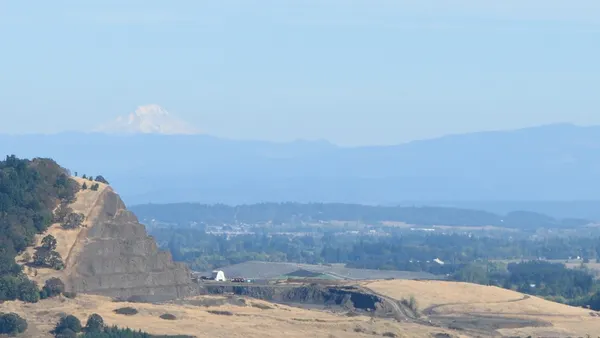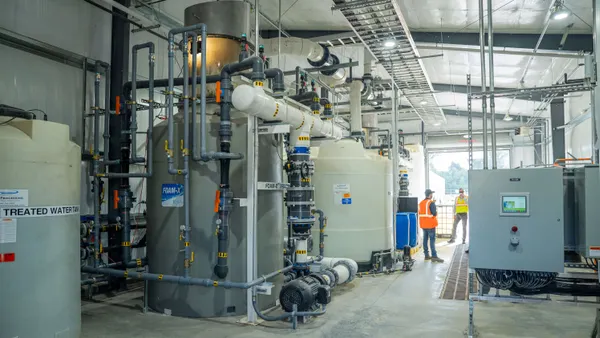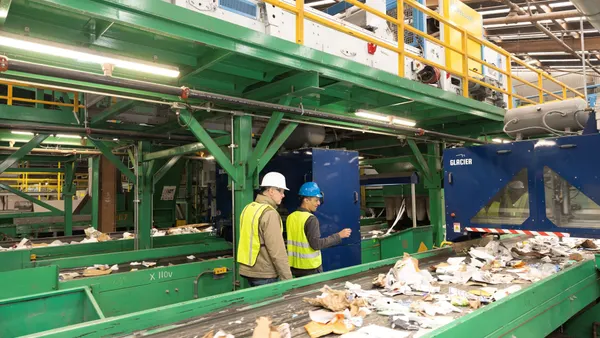King County, Washington, is running out of local options to manage its waste.
The most populous county in the state recently bought itself some time by convincing partner cities to expand its Cedar Hills Regional Landfill again, but that will only solve the area’s waste problem for another two decades. After that, the landfill is out of space, unless the county can somehow convince rancorous neighboring residents to remove height restrictions or allow expansion into buffer zones. For the time being, local officials are exploring other alternatives, with landfill critics arguing that waste-to-energy is the best option.
A report released last month by consulting firm Arcadis lends further evidence to the case supporters are mounting for WTE, finding the county could save up to $7.2 billion over the long-term by incinerating waste versus exporting it to other landfills after Cedar Hills closes. If a handful of politicians and local WTE advocates had their way, the county would let go of landfilling sooner rather than later, potentially making King County home to one of the first new incinerators the United States has seen in years.
“There are many things King County does that are the largest, the biggest, the first,” County Councilmember Kathy Lambert, who has advocated for WTE since 2006, told Waste Dive. “Do we want to be forward-thinking, practical and make sure that we are setting ourselves up to be self-sufficient?”
The Cedar Hills landfill serves all but two cities in King County – Seattle and Milton – and could reach capacity as soon as 2025. The county council approved a solid waste plan that included the expansion in April on a 5-2 vote. Lambert, one of the dissenting voters, called the plan “disappointing and short-sighted.”
Waste Dive contacted all five council members who voted in support of the plan. As of publication, the members either hadn’t responded or declined to comment.
Most of the county’s 37 partner cities approved expansion this fall, and the landfill cleared another hurdle this month when the Washington Department of Ecology gave the green light to the county’s new solid waste plan. But critics continue to argue a WTE plant would be a more forward-thinking and environmentally friendly solution.
“The rest of the world is going to be so far ahead of us in using technology to deal with this problem,” said Lambert.
Regional debate, national implications
The county’s newly approved Comprehensive Solid Waste Management Plan evaluated both WTE and exporting waste by rail to meet future needs, but ultimately landed on expansion as the most cost-effective and least disruptive near-term option.
The Cedar Hills landfill, owned and operated by King County, has been operational since the 1960s. Per the plan, it is the only active landfill in the county and buried more than 931,000 tons of municipal waste in 2017.
The plan calls for adding new disposal capacity to the 920-acre site by moving most of its administrative and maintenance buildings at a cost of up to $270 million. It also recommends increasing the landfill’s permitted height by 30 feet, potentially extending its lifespan until 2040.
Numerous partner cities and unincorporated areas rely on the site through an interlocal waste agreement. Three of those cities rejected expansion and 24 supported it, according to King County Solid Waste Director Pat McLaughlin. The remaining cities took no action.
“We had basically close to 90% of the population, 88.7%, who took action one way or the other,” McLaughlin told Waste Dive. “So there’s strong support and endorsement of the plan.”
The Bellevue City Council, which represents the largest city in Cedar Hills’ service area, was among those that voted unanimously in support of the plan – in part because of a January 2018 public comment period that led to several amendments.
Those amendments reaffirm the county’s commitment to stay out of landfill buffer areas and cap the elevation of certain cells in alignment with a 1990s lawsuit settlement. The amendments require the county to be more transparent with its groundwater monitoring and leachate reports, explore ways to reduce road impacts in unincorporated areas, and looks for ways to mitigate issues caused by eagles scavenging the site. They also require the county to develop a plan that explores disposal options once Cedar Hills closes for good.
“This is really pretty exciting to get to this point,” said Bellevue Councilmember John Stokes during a June 24 meeting when the council approved the plan.
At that time, members praised King County Solid Waste for its willingness to collaborate and listen to participating cities’ concerns.
“I like the amendments,” said Councilmember Janice Zahn. “It looks like this is both a short-term [strategy for] what we can do while we’re still at the current landfill, as well as ... a plan for the future.”
Still, not all cities have voiced the same support.
The Snoqualmie City Council was among those who rejected expansion, with Mayor Matt Larson sending a September letter to the county urging further evaluation of WTE instead of “casual dismissal.”
“We knew [the vote] wasn’t going to have an impact, but we wanted to use the opportunity to send a stronger message,” Larson told Waste Dive.
In SeaTac, council members called the plan “shortsighted” and voted it down 5-2.
“This feels like kicking the can down the road, and the road is going to come to an end really fast,” Mayor Erin Sitterley said during a Sept. 10 meeting. “I don’t see the solution in this particular document.”
Councilmember Peter Kwon offered dissenting comments and a vote in favor of the plan.
“I’ve gotten tons of emails from people all over the county saying their concerns – ‘vote it down, this is bad.’ There are no alternatives proposed,” Kwon said. “Currently this is the best available option.”
The expansion approval process also drew some vocal critics among the county’s residents, who expressed their views in local meetings and op-eds.
“The entire plan is written in a way that it becomes very clear how one is supposed to decide,” said Newcastle resident Phillipp Schmidt-Pathmann during a city council public comment period in September. Newcastle is among the cities that ultimately voted against landfill expansion.
“It is likely that according to this plan the vast majority of King County citizens will believe the landfill is cheap, safe and environmentally friendly and everything else is expensive, dangerous and distressing,” but that conclusion is false, Schmidt-Pathmann said.
A German expat and longtime waste consultant, Schmidt-Pathmann introduced Councilmember Lambert to WTE (along with other materials management technology and policy frameworks) during tours through Europe in 2006 and 2007. He pushed for the newly released report by Arcadis, as well as a study in 2017 by Normandeau Associates that provided a synopsis of WTE technologies and trends around the world.
The Normandeau study identified WTE advantages that include reduced landfill volume, improved air and water quality, and energy generation. Disadvantages include high up-front capital costs and challenges with quantifying a plant’s greenhouse gas emissions as compared to exporting. Schmidt-Pathmann noted that comparison was addressed in the Arcadis study, but not when it comes to comparing WTE emissions to the current landfill.
Schmidt-Pathmann told Waste Dive the benefits outweigh the costs and a state-of-the-art WTE facility in Washington – that is part of an integrated resource management system, emphasizing waste reduction first – could help move the rest of the nation away from landfilling. He pointed to the European Union, which has a binding target to send only 10% of municipal waste to landfills by 2030 and robust support for WTE plants, as a model.
Yet the only WTE plant to open in the United States since 1995 is the Palm Beach facility in Florida, which came online in 2015, and multiple sites have closed or face closure in the years since. The vast majority of the nation’s estimated 70 WTE facilities are located on the East Coast, with less than a handful in the West, according to a 2018 report by the Energy Recovery Council.
“If they would allow King County to have a waste-to-energy plant, many other states will pay attention,” said Schmidt-Pathmann, adding that this would be especially notable due to the dominance of landfills in the U.S. and Washington's image as an environmental leader. “You could see a renaissance in green energy.”
The costs of status quo
Amid discussions about the county’s future disposal plans, debate continue to percolate over how the current landfill is operated. Officials have extended the Cedar Hills facility’s closure date numerous times in the last two decades, stoking tensions with nearby residents and fueling lawsuits.
“They’re not interested in doing waste-to-energy plants. They want this landfill,” Janet Dobrowolski, who has lived on a property bordering the landfill for 33 years, told Waste Dive.
Neighbors like Dobrowolski have become especially frustrated with birds picking through garbage at the site and dropping it on their properties.
“They have about 200 eagles up there. In the spring they are very active,” she said. “We get a lot of garbage – diapers, real nasty stuff that shouldn’t be in people’s yards.”
Dobrowolski said she has also dealt with odors from a nearby composting facility, but her biggest concern is the environmental impact from unlined landfills like Cedar Hills.
Cedar Hills did add a gas-to-energy facility in 2010, which captures much of the landfill’s methane (though opponents dispute how much is captured). But a preliminary study commissioned by the county in 2016 found leachate from the oldest sections of Cedar Hills could seep into the regional aquifer by 2058.
Still, Director McLaughlin claims landfill expansion is both the most sustainable and least-expensive option.
“One of the fundamental realities is we could not site, design, build and have ready for operation (a WTE plant) in less than 10 years,” or before the landfill reaches capacity without expansion, he said. “That’s not a feasible period for planning and operation. That’s a fundamental fact.”
But others disagree, and even the solid waste plan essentially acknowledges the county will face a decision point sooner rather than later. “[The] Cedar Hills landfill capacity will ultimately be exhausted and a new disposal option will be needed," the plan notes.
“In 2017, we studied a variety of technologies, though that zeroed in on mass burn as most appropriate should we elect to move forward,” McLaughlin said. “These technologies will continue to evolve and we will keep an eye on them.”
While some municipal officials believe expanding the landfill is the most sensible near-term option, WTE advocates wonder why county officials are ignoring other technologies.
“We need to modernize,” Mayor Larson of Snoqualmie said. “We’ve got to escalate this conversation and look at doing this now.”
Last month, King County released a feasibility study by Seattle-based Arcadis comparing construction and operation of a WTE facility with shipping waste by rail to landfills in eastern Washington and Oregon. The latter practice is similar to Seattle’s current situation.
While the solid waste plan concluded WTE and waste export were more expensive than expanding the landfill, the Arcadis study did not include a comparison with local landfilling.
Over the long term, however, the study deemed WTE to be the least expensive and most environmentally sound option, providing the county with more long-term stability than waste export. It also found a plant could be built to meet the county’s needs in about 10 years. Arcadis estimates an initial cost of $1.1 billion, growing to as much as $8.9 billion over a 50-year term to meet expanding needs.
That high up-front cost is a primary reason McLaughlin and the county plan recommended landfill expansion instead of WTE. But Councilmember Lambert said she finds the cost reasonable, considering the county recently spent $1.8 billion on its Brightwater wastewater treatment plant.
The Arcadis study anticipates saving at least $99 per ton over the long-term with WTE versus rail. In a shorter, 10-year term – based on a low-bound forecast – the study found WTE would cost about $107 per ton versus $110 to ship by rail.
The Arcadis study also projects the county could save another $100 million in land purchase costs and $350 million in ash hauling costs if it sites a WTE plant at the Cedar Hills landfill – assuming there’s enough space left.
Mayor Larson worries that using all of Cedar Hills’ developable space for waste burial means there won’t be room to build a WTE plant at the site.
“Logically and politically, it’s easiest to site at the current landfill,” he said. “They’re going to end up undermining that ability.”
But another issue looming over waste burning is greenhouse gas emissions. The Arcadis study estimates WTE will generate .42 tons of CO2 per ton and Washington law requires electricity generators to be carbon neutral after 2030. By 2045, generators must source energy from renewables. Washington does not consider WTE a renewable resource, but does grant that status to landfills capturing gas from the same waste.
King County would likely have to install carbon capture technology and lobby the state legislature for exemptions to ensure a WTE plant’s long-term viability, but that doesn’t faze Lambert. Once lawmakers see a state-of-the-art facility in action, she said, they’ll undoubtedly recognize the benefits as compared to impacts from the landfill.
“Certainly having 920 acres of garbage almost 800 feet above sea level has lots and lots of environmental impacts they seem to ignore,” Lambert said. “We need to look at the whole package.”
Next steps
Beyond the practical considerations, a final hurdle could be public perceptions about WTE. Like much of the nation, the Seattle area soured on incinerators decades ago due to the high emissions associated with older mass burn technology.
Capacity issues at Cedar Hills specifically raised alarm as early as the 1980s, when both the city and King County planned to transition away from landfilling and send garbage to a mass burn facility. Officials abandoned those plans after protests from environmental groups and the public.
Lambert acknowledges that negative public perceptions linger, but says the comparisons are outdated.
“I tell people when they think of a waste-to-energy plant, they think of [the equivalent of] a Commodore 64 computer, and that’s not what computers look like today,” she said. “We will be building something much more technologically savvy.”
McLaughlin, however, said WTE isn’t an inevitable solution for the region’s waste, despite county-commissioned studies touting its benefits.
“We remain open to the possibility of a future waste-to-energy facility as part of our long-range planning,” the waste director wrote in an email. “However, the notion that our disposal option choices are binary – landfilling vs waste-to-energy – is not really the case when we as a region have a tremendous opportunity to pursue a broader set of options.”
The only additional option McLaughlin mentioned is improved recycling, noting that about 70% of the waste landfilled at Cedar Hills is reusable or recyclable.
“We’re just starting to engage our customer agencies, partners and stakeholders in a regional conversation, which will include re-examining a business model that incentivizes bringing more garbage across our scales,” McLaughlin said. “As tempting as it may be to jump in on a specific element such as disposal, we need to approach this work very thoughtfully.
Correction: This piece has been updated to specify renewable energy status for landfill gas in Washington and the nature of GHG comparisons in different consultant studies.









